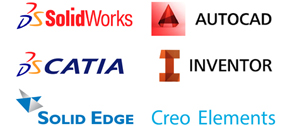Apple was once on the brink of complete failure years ago, but its revolutionary iMac, an all-in-one machine that houses the computer inside the monitor, was the beginning of a new, profitable era for the company.
Last year, Apple polished the design, making it thinner than its predecessors. Now, the latest iMac is just as beautiful as it is powerful. There is, without a doubt, no better all-in-one desktop computer.
Skinny Machine That's Thin on Ports
The original iMac was fat and bulky, but it somehow managed to cram a full computer into the already distastefully obese CRT monitors of the time. This iMac is perfectly flat on the front; the 27-inch display is outfitted with a laminated pane of glass that also covers the black bezel leading to the bottom aluminum chassis, perfectly anodized except for the reflective logo.
The back is another story, curvy in a way that’s almost impossible to imagine outside of some sci-fi show. Sure, it looks thick from the side, but will you every look at the backside of your machine?
The base holds everything upright while providing up to 40 degrees of movement. So, if you’re a standing desk kind of person, tilting the display up is more than enough, thanks in part to exceptional viewing angles. In fact, the display is so good that it’s almost unbelievable. The color accuracy, light, contrast and dark levels are so near perfect that professional photographers could use it without any calibration, right out of the box.

The 2560 X 1600 pixel resolution display is massive. I sat down for two days with the iMac and an older Cinema Display, and, as someone who lives on a three-monitor setup, I barely needed the second Mac screen.
Everything is so nicely put together that the lack of ports is, at first, unnoticeable, but it very quickly becomes punishing. Four USB 3.0 ports is just not enough; this is a USB world we live in, after all. Even if you use the included Apple Wireless Keyboard and either the Magic Mouse or Magic Trackpad, there are plenty of USB devices left over to plug in.
Two Thunderbolt ports is silly because there are only two things Thunderbolt is used for: Apple’s own displays and expensive external hard drives. Also, the ports are made to be daisy chained, so why not include just one and put two more USB ports instead? It may seem moot, but the nine ports — audio jack, SDXC card reader, 4X USB 3.0, 2X Thunderbolt, Ethernet — just aren’t convenient enough.
Under the Hood: Power and Hardware
If you’re looking at an iMac instead of the more popular MacBook Pro Retina, it must be for one of two reasons: You don’t care about portability, or you want power. The iMac has plenty of both.
Apple has two models, the 21-inch and 27-inch, and the components are almost identical, aside from the processors — the 21-inch base has a 2.7 GHz quad-core Intel i5, the 27-inch a 3.2 GHz i5. Both come with 8 GB of RAM and start with a 1 TB hard disk drive (HDD). The tested unit, courtesy of Apple, included a 3.4 GHz quad-core i5, 8 GB of RAM, and an NVIDIA GeForce GTX 775M video card, plus Apple’s proprietary 1 TB Fusion Drive (retail $2,199).
The Fusion Drive is a hybrid HDD plus a 128 GB solid state drive (SSD). Like a hybrid car, the point of the Fusion Drive is to provide balance between speed and capacity versus price. The standalone SSD devices at high capacities are still wildly expensive. The Fusion Drive offers the same kind of speed for your most-used applications without leaving you short on space for all of those movies and music you’ve kept for years.
It does a fine job, too. I’ve only ran into minor slowdowns, generally after playing a lot of games and suddenly jumping into Photoshop. Apple’s software does an excellent job of prioritizing speed based on what you use the most.
Overall performance is excellent. The iMac is blazing fast. The only time it had trouble running anything was one game, The Witcher 2, which chugged along at 20 frames per second when displaying at full resolution. Lower the display resolution down to 1920 X 1440 pixels, and it runs at a fairly smooth 33 frames per second. Another high-powered game, Metro: Last Light, runs at the highest settings without the slightest drop in performance.
If you don’t have an Ethernet cable available, Wi-Fi performance is likewise excellent. The iMac supports 802.11ac, also available in the new Airport Extreme and Time Capsule. Speeds hover around 500 MBps within line of sight, and jump as high as 750 MBps.
Simplicity for Average Users, Power for Prosumers
If there’s one thing this iMac is not, it’s messy. Apple managed to make this desktop as much like a laptop as humanly possible without strapping on a battery.
Aside from the power cable, you don’t need a thing. Bluetooth 4.0 provides excellent wireless support for mice, keyboards and other peripherals. The 802.11ac support offers excellent data transfer speeds over Wi-Fi. There’s no reason to not be that guy that uses his iMac at Starbucks.
If you’re more of a "prosumer," the kind of person who needs tons of raw power and speed, then this machine offers all that, too. I simultaneously ran multiple displays, external hard drives and connected six iOS devices. There was no was no slowdown whatsoever with dozens of browser tabs open and applications running, plus XCode running apps on all connected iOS devices. Heck, the slowest part of the test was finding enough Lightning cables.
The only people who would find the iMac too weak are the professionals who want to run a lot of photo and video editing software across multiple hard drives and displays at high — we’re talking 4K — resolutions. The right machine for that kind of processing is the upcoming Mac Pro, due out in December.
Money Talk: Reasonable Base, Pricey Upgrades
The iMac succeeds in so many different ways that there's no true competitor. It’s an excellent desktop computer. And, for most people, it’s near perfect, especially with a starting price of $1,299 for the 21-inch and $1,799 for the 27-inch models.
Users looking for a little more oomph will find some basic flaws, like too few ports and the port placement. However, the hardest bit to stomach is the upgrade pricing structure, which is insanely expensive.
Doubling the RAM to 16 GB will set you back $200 — about $100 more than it should cost. Jumping to a better video card costs at least $200 for the next model. And Apple touts Fusion Drive as the end-all solution to high-speed and high-capacity drives for desktops, but it still ships the base iMac with a standard 1TB HDD. The starter Fusion Drive is another $200.
Even with high pricing for basic upgrades, the iMac is exactly what a Desktop should be: simple, clean, efficient, comfortable and, most importantly, powerful. No matter which model you choose, it’s a machine that’ll easily last three to five years, and you’ll love every second.
The Lowdown
Pros:
Beautifully built
Gorgeous display
Blazingly fast performance
Minimalistic, yet feature-packed
Cons:
Bottom Line
It’s pricey, but you can’t ask for a more stunning desktop computer.
Have something to add to this story? Share it in the comments.
Images: James Pikover, Mashable
via apple - Google News http://news.google.com/news/url?sa=t&fd=R&usg=AFQjCNEyxLMgInCLBdjAXFLdZFBx7pH4GQ&url=http://mashable.com/2013/11/26/apple-27-inch-imac-review/













0 comments:
Post a Comment